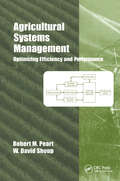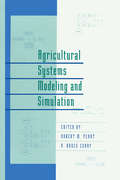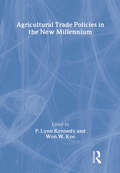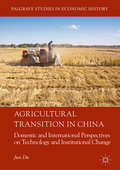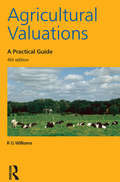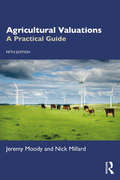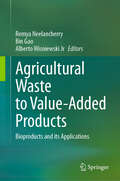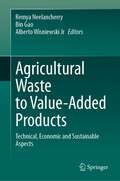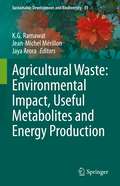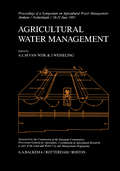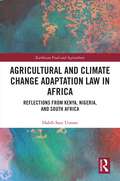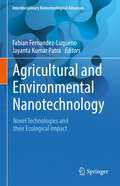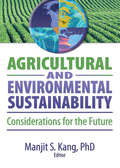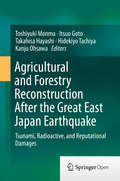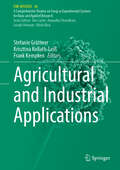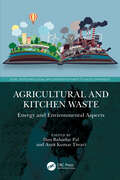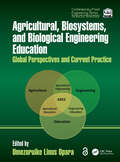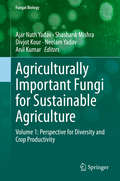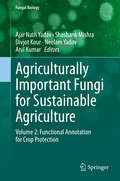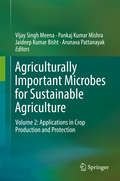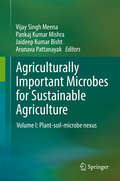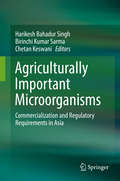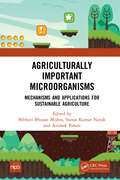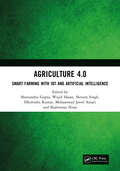- Table View
- List View
Agricultural Systems Management: Optimizing Efficiency and Performance
by Robert M. Peart; W. David ShoupRunning a productive agriculture system has always been about having the right tools and the know-how to pursue optimization and efficiency. In the 21st century, the case can be made that the agriculturist's most important tool is not the cultivator, but the computer. While you still need to know how to adapt to the day-to-day challenges of land an
Agricultural Systems Modeling and Simulation (Books in Soils, Plants, and the Environment)
by Robert M. Peart R. Bruce CurryOffers a treatment of modern applications of modelling and simulation in crop, livestock, forage/livestock systems, and field operations. The book discusses methodologies from linear programming and neutral networks, to expert or decision support systems, as well as featuring models, such as SOYGRO, CROPGRO and GOSSYM/COMAX. It includes coverage on evaporation and evapotranspiration, the theory of simulation based on biological processes, and deficit irrigation scheduling.
Agricultural Trade Policies in the New Millennium
by P. Lynn Kennedy Andrew D O'Rourke Won W KooFace the challenge of change in the global agricultural trade market!This insightful book presents a comprehensive overview of the trade situation facing agriculture in the 21st century. This esteemed collection of the field?s foremost researchers evaluates anticipated changes to the agricultural trade market and the competitiveness of commodities and products resulting from existing and potential international policies. Agricultural Trade Policies in the New Millennium provides an in-depth understanding of multilateral trade negotiations (past, present, and future) and the impact of regionalism on agricultural trade. It also analyzes trade issues specific to individual commodities, such as rice, wheat, and cotton.Agricultural Trade Policies in the New Millennium consolidates essential trade research into a one-of-a-kind reference source for economists, academics, and agriculture professionals. The book provides a detailed overview of current and potential trade situations, divided into three concise sections: key issues influencing trade negotiations from the perspective of developed and developing countries and the environment; commodity trade and trade policy issues concerning competitiveness and the international policy environment for coarse grains, cotton, rice, sugar, and wheat; and general issues related to multilateral and regional trade agreements, including policy tools within the World Trade Organization, anti-dumping actions, regionalism, price volatility, and the macroeconomic effects of trade liberalization. Agricultural Trade Policies in the New Millennium examines: key issues influencing trade negotiations commodity trade and trade policy issues issues and concerns related to multilateral and regional trade negotiations challenges facing trade policy prospects for the agricultural sector in the new millennium With international policy issues like the WTO’s Millennium Round and the Free Trade Area of the Americas (FTAA) in negotiation and a new United States farm bill pending, Agricultural Trade Policies in the New Millennium provides much-needed textbook analysis by expert researchers. This vital book will keep you in touch with current trade negotiations and policy decisions that are certain to hold major implications for the agricultural sector.
Agricultural Transition in China: Domestic And International Perspectives On Technology And Institutional Change (Palgrave Studies In Economic History)
by Jun DuDeepens readers’ understanding of the nature of contemporary Chinese economic development .<P><P> Relaxes the hypothesis of the perfect market condition to discuss institutional and technological changes in Chinese post-reform agriculture under the complex market institution.<P> Highlights the decisive role of market institutions in determining the selection and transition of agricultural technologies.<P> This book extends current research on the political economy of modern China, with particular regard to agricultural development and its role in economic transition. It uses Neoclassical principles to re-interpret agricultural growth and technological change under complex market institutions with empirical studies on China and selected East Asian economies. The text also questions how technological advances in China contribute to the Great Divergence debate.<P> Through a comparative analysis of agricultural technical changes in the planting of rice paddies in Japan, Taiwan and China, Du finds that different market institutions and structures have given rise to considerable diversity of agricultural change between different economies in terms of the nature, timing and duration of technological transition. Such diversification has, in turn, affected the trajectories of agricultural and wider economic growth.<P> Here, Du reflects on the nature of contemporary Chinese economic development and extends observations on agricultural transition to the entirety of Asia, finding that the nature, timing, and time-span of agriculture technology transitions have varied considerably across different economies. <P>
Agricultural Valuations
by R.G. WilliamsAgricultural Valuations, now in its fourth edition is written by a practising agricultural valuer who has been working in property for over 50 years. His analysis updates recent changes to tenant right valuations, improvements, fixtures, milk quotas and dilapidations. The author uses numerous example claims and valuations which shed light on recent pipeline and electricity line wayleave claims, notices to remedy breaches, together with probate, income tax and compulsory purchase valuations. Further chapters deal with the guiding principles of how to correctly value farms, assess farm rents, carry out arbitrations, inventories and records of condition. valuation clauses on sales of farms, livestock, soils, management agreements, valuation in court proceedings and a glossary of useful information. This practical, but detailed title will be invaluable to students, agricultural valuers and land agents who are looking to be kept apprised of up to date best practices. The author was awarded the ‘Kenneth Glenny’ Prize by the Central Association of Agricultural Valuers when the first edition was published in 1984. Since then the book has been expanded brought up to date to reflect changes that have occurred to rural communities.The author, a member of a North Wales farming family, was Senior Partner of Coles Knapp and Kennedy, Ross-on-Wye. An experienced farmer himself, he keeps cattle and sheep, grows arable crops and also grows cider apples and hops in Herefordshire. He was involved for over 25 years in training candidates for the examination of the Central Association of Agricultural Valuers and for many years the RICS TPC in agricultural practice.
Agricultural Valuations: A Practical Guide
by Jeremy Moody Nick MillardAgricultural Valuations: A Practical Guide has long been the standard text for students and professionals working on agricultural valuations. Taking a practical approach, it covers all the relevant techniques and legislation necessary to correctly value farms, assess farm rents, carry out arbitrations, inventories and records of condition, including valuation clauses on sales of farms, livestock, soils, management agreements, valuation in court proceedings and a glossary of useful information. In this fifth edition, Gwyn Williams's original text is taken on by Jeremy Moody and Nick Millard, renowned experts in the field, bringing the book right up to date to reflect recent changes in the rural economy, including development, diversification and renewable energy and specialist valuations and reference to all the latest legislation. Clear and accessible to students and professionals alike, readers will find Agricultural Valuations an invaluable guide to best practice in agricultural valuations.
Agricultural Waste to Value-Added Products: Bioproducts and its Applications
by Bin Gao Remya Neelancherry Alberto Wisniewski JrThis book provides awareness about utilizing the agricultural waste to assist sustainable development goals (SDGs) through the adaptation of such waste-to-energy technologies. It discusses the synthesis, characterization, and environmental utilization of biofuels produced from agriculture-derived wastes. The application of circular economy, insights and opportunities of recent issues, and ideas for the potential enhancement of agricultural waste-derived products are also explored. About a third of all biomass waste is produced by agriculture, making it one of the largest contributors to global biomass waste. Different biochemical and thermochemical processes can transform this waste into a wide range of value-added products. Such biomass-to-biofuel trends have gained a prominent status in the global energy system. And the agro-waste-derived products can provide potential solutions to a wide range of environmental problems. The primary audience shall be academicians, researchers, engineers, scientists, and managers working in the field of agricultural residue management and waste biomass to energy.
Agricultural Waste to Value-Added Products: Technical, Economic and Sustainable Aspects
by Bin Gao Remya Neelancherry Alberto Wisniewski JrThis edited book provides a comprehensive review of the current agricultural waste disposal techniques focusing on the ongoing research in the production of various agro waste-derived value-added products. Further topic includes the techno-economic aspects in up-scaling the technology from lab scale to commercial/pilot scale. Sustainable waste management and alternative renewable energy sources are the most important requirements in this era of rapid industrialization and urbanization. Agricultural waste, which is one of the major contributors to overall waste production, has the ability to be an essential source of renewable energy and other valuable products. The ongoing research and technical advancements in agro-waste treatment lead to the efficient conversion of waste into different value-added products. This book is of primary interest to academicians, researchers, scientists and engineers working in the field of agro-residue management, and biomass to bio-energy conversion technologies. Also, the book serves as reading material for students of Environmental Engineering/Civil and Environmental Engineering and Agricultural Engineering. Rural Management authorities, Industrial and Government policy-making agencies may also find it useful read.
Agricultural Waste: Environmental Impact, Useful Metabolites and Energy Production (Sustainable Development and Biodiversity #31)
by K. G. Ramawat Jean-Michel Mérillon Jaya AroraThis contributed volume deals with problems associated with huge biomass generated by crop plants and the processing of fruits and food materials. The main focus is to address problems associated with organic residues from agro-industrial processes. This book aims to provide a comprehensive and up-to-date account of various processes involved in the valorization of this huge biomass available from agro-industrial processes and obtaining valuable primary and secondary metabolites which will have an impact on the rural economy. Decrease in forest cover associated with the production of agriculture-based waste resulting in pollutants like smoke by burning of residual crops, waste from breweries, food processing, pruning of bushes and trees, and from industries producing proteins, vegetable oils and fruit juices etc.This book is of interest to teachers, researchers, climate change scientists, agriculture scientists and policymakers. The book brings out the latest reading material for botanists, biotechnologists, environmentalists, biologists, policymakers and NGOs working for environmental protection.
Agricultural Water Management
by A. L. Van Wijk Wesseling J.This book is an outcome of the symposium on agricultural water management in Netherlands and discusses the methods that leads to cost effective but environmentally acceptable techniques. The book covers following topics: drainage and reclamation of soil and effect of drainage on agriculture.
Agricultural and Climate Change Adaptation Law in Africa: Reflections from Kenya, Nigeria, and South Africa (Earthscan Food and Agriculture)
by Habib Sani UsmanThis book presents an analysis of climate change and agricultural laws in Kenya, Nigeria, and South Africa in order to determine whether they adequately addressed the concept of agricultural adaptation.Agriculture is one of the sectors of the economy that is contributing to climate change, and at the same time the sector is heavily impacted by climate change. Therefore agricultural adaptation is required. Focusing on three countries, this book provides a novel, comparative examination of how and to what extent the law promotes agriculture-focused adaptation in these countries. The role of the law in addressing issues such as water management strategies, soil conservation methods, and crop production methods is discussed. This book identifies gaps in the regulatory frameworks for agricultural adaptation and highlights the lack of adaptive capacity of African agriculture due to weak or non-existing legal frameworks. It discusses ways to remedy these gaps through specific on-farm adaptation strategies, legislative amendments to consolidate all relevant national climate change-related policies and laws with agricultural policies and laws that have relevant provisions on adaptation as medium-term solutions, and the development of a specific framework law for agriculture-focused adaptation, incorporating essential agricultural adaptation strategies, could perhaps be enacted as long-term solutions to the regulatory gaps.This book will be of great interest to students and scholars of law, climate change, food and agriculture, sustainable development, and African studies.
Agricultural and Environmental Nanotechnology: Novel Technologies and their Ecological Impact (Interdisciplinary Biotechnological Advances)
by Jayanta Kumar Patra Fabian Fernandez-LuquenoThis book highlights the best practices regarding nanoscience and nanotechnology for agriculture and environmental sectors to shape sustainable development thought to improve the quality and quantity of the agriculture products and to decrease the collateral effect of nanotechnology in the ecosystems. Besides, leading nanotechnologies are showed and discussed to guarantee their proper management in lands and ecosystems. Therefore, nanotechnologies such as agronanobiotechnology, nanofertilization, pest control, magnetofection for plant breeding, plant molecular farming, OMICs technologies, phytonanotechnology, nanoremediation, etc. are described in five sections and 21 chapters. Undoubtedly it is an ideal and updated book for undergraduate or postgraduate students, and scientists or researchers involved in nanoscience, nanotechnology, crop production, and remediation technologies as well as for those researchers that solving technical problems regarding the crop management and the human and environmental health without hampering the pursuit of sustainable development goals.
Agricultural and Environmental Sustainability: Considerations for the Future
by Manjit S. KangUnderstand sustainable development from economic, ecological, and social perspectivesAs world population continues to increase, the need grows for a safe, sustainable supply of food. Agricultural and Environmental Sustainability: Considerations for the Future provides the latest research results and vital information on the process of p
Agricultural and Forestry Reconstruction After the Great East Japan Earthquake: Tsunami, Radioactive, and Reputational Damages
by Toshiyuki Monma Itsuo Goto Takahisa Hayashi Hidekiyo Tachiya Kanju OhsawaThis book summarizes the results of 3 years of agricultural and forestry reconstructive efforts and applied research conducted directly in the affected areas of Fukushima following the Great East Japan Earthquake. It describes fast and effective revival methods and technologies from tsunami and radiation damages, demonstrated through the collaborative efforts of researchers, students, local farmers, forest owners, and municipalities gathered under the Tokyo University of Agriculture East Japan Assistance Project. Consisting of four parts, the first part of the book provides an overview of the damage and measures taken to overcome them by the local municipalities and the Tokyo University of Agriculture. The second part presents data and results of agricultural recovery from the tsunami--for example, monitoring systems, reconstruction models, and convenient, low-cost methods developed for the restoration of tsunami-damaged paddy fields. The third part focuses on recovery from radiation-contaminated farmlands and forests and consequent reputational damages. Included are various primary data obtained from field experiments and surveys, studies on the mechanism of contamination, and the results of radical monitoring, decontamination, and restoration techniques performed at this site. The final part is a collection of reflections of local farmers, forest owners, and students who participated in the project. The academic trials and errors recorded in this book are an invaluable contribution to disaster management and recovery processes. It is written for a wide audience, not limited to researchers and students, but also for government and state officials, municipalities, agricultural cooperative staff members, and farmers.
Agricultural and Industrial Applications (The Mycota #16)
by Frank Kempken Stefanie Grüttner Krisztina Kollath-LeißThis volume provides an overview of the current state of the art in agricultural and industrial mycology. It highlights the importance and potential of fungi in these fields. Several topics relate to the critical and ambiguous role of fungi in agriculture, including beneficial and pathogenic fungal-plant interactions and food spoilage caused by mycotoxins. In addition, this volume provides a fascinating insight into ergot alkaloids. The impact of climate change on the occurrence of pathogenic fungi is also discussed. Fungi play an important role in a wide range of industrial processes, including the fermentation of food and beverages and the biotechnological production of metabolites and enzymes. A number of specific applications are discussed in this volume, such as the production of vitamins and enzymes from marine fungi. In addition to mycologists working in industry, agriculture and academia, the book will be of interest to students of biotechnology, microbiology and mycology. Chapter 3 is available open access under a Creative Commons Attribution 4.0 International License via link.springer.com.
Agricultural and Kitchen Waste: Energy and Environmental Aspects (Novel Biotechnological Applications for Waste to Value Conversion)
by Dan Bahadur Pal Amit Kumar TiwariApart from being termed as a pollution source, agriculture and kitchen waste is also a rich source of carbohydrates, minerals, antioxidants and vitamins, and can be utilized to develop value-added products and for energy production, which is the main theme of this book. It also focuses on the minimization of this waste via different routes like conversion into bio-fertilizers, organic acids, other industrial products, and efficient energy production. It comprises different topics and concepts related to waste utilization contributed by recognized researchers and experts. Features: Covers all the technical aspects of utilization of agricultural and kitchen waste. Discusses the quality characteristics of value-added products. Provides overview of different options for processing of organic wastes. Includes production of acids and enzymes from agriculture/kitchen wastes. Reviews effects of kitchen/agricultural waste on environment and its role in pollution control. This book is aimed at researchers and graduate students in chemical and environmental engineering.
Agricultural, Biosystems, and Biological Engineering Education: Global Perspectives and Current Practice (Contemporary Food Engineering)
by Umezuruike Linus OparaAgricultural engineering, developed as an engineering discipline underpinned by physics, applies scientific principles, knowledge, and technological innovations in the agricultural and food industries. During the last century, there was exponential growth in engineering developments, which has improved human wellbeing and radically changed how humans interact with each other and our planet. Among these, “Agricultural Mechanization” is ranked among the top 10 in a list of 20 Top Engineering Achievements of the last century that have had the greatest impact on the quality of life.While many success stories abound, the problems of low appeal among students, identity crises, and limited job opportunities in many climes continue to trouble the discipline’s future in many parts of the world. Yet agriculture and agricultural engineering remain fundamental to assuring food and nutrition security for a growing global population.Agricultural, Biosystems, and Biological Engineering Education provides the first comprehensive global review and synthesis of different agricultural, biosystems, and biological engineering education approaches, including a detailed exposition of current practices from different regions.Key Features: Describes novel approaches to curriculum design and reform Outlines current and emerging epistemology and pedagogies in ABBE education Provides a framework to grow agricultural engineering in Africa and other developing regions Highlights the role of ABBE education in the context of the SDGs Presented in 3 parts and containing 42 chapters, this book covers the historical evolution of agricultural engineering education and discusses the emergence of biological and biosystems engineering education. It will appeal to engineers and other professionals, education planners and administrators, and policy makers in agriculture and other biological industries.Chapters 4, 11, 19, 32, and 41 of this book are freely available as a downloadable Open Access PDF at http://www.taylorfrancis.com under a Creative Commons Attribution-Non Commercial-No Derivatives (CC-BY-NC-ND) 4.0 license.
Agriculturally Important Fungi for Sustainable Agriculture: Volume 1: Perspective for Diversity and Crop Productivity (Fungal Biology)
by Anil Kumar Ajar Nath Yadav Shashank Mishra Neelam Yadav Divjot KourMicrobes are ubiquitous in nature. Among microbes, fungal communities play an important role in agriculture, the environment, and medicine. Vast fungal diversity has been associated with plant systems, namely epiphytic fungi, endophytic fungi, and rhizospheric fungi. These fungi associated with plant systems play an important role in plant growth, crop yield, and soil health. Rhizospheric fungi, present in rhizospheric zones, get their nutrients from root exudates released by plant root systems, which help with their growth, development, and microbe activity. Endophytic fungi typically enter plant hosts through naturally occurring wounds that are the result of plant growth, through root hairs, or at epidermal conjunctions. Phyllospheric fungi may survive or proliferate on leaves depending on material influences in leaf diffuseness or exudates.The diverse nature of these fungal communities is a key component of soil-plant systems, where they are engaged in a network of interactions endophytically, phyllospherically, as well as in the rhizosphere, and thus have emerged as a promising tool for sustainable agriculture. These fungal communities promote plant growth directly and indirectly by using plant growth promoting (PGP) attributes. These PGP fungi can be used as biofertilizers and biocontrol agents in place of chemical fertilizers and pesticides for a more eco-friendly method of promoting sustainable agriculture and environments.This first volume of a two-volume set covers the biodiversity of plant-associated fungal communities and their role in plant growth promotion, the mitigation of abiotic stress, and soil fertility for sustainable agriculture. This book should be useful to those working in the biological sciences, especially for microbiologists, microbial biotechnologists, biochemists, and researchers and scientists of fungal biotechnology.
Agriculturally Important Fungi for Sustainable Agriculture: Volume 2: Functional Annotation for Crop Protection (Fungal Biology)
by Anil Kumar Ajar Nath Yadav Shashank Mishra Neelam Yadav Divjot KourMicrobes are ubiquitous in nature. Among microbes, fungal communities play an important role in agriculture, the environment, and medicine. Vast fungal diversity has been found in plant systems. The fungi associated with any plant system are in the form of epiphytic, endophytic, and rhizospheric fungi. These associated fungi play important roles in plant growth, crop yield, and soil health.The rhizospheric fungi present in rhizospheric zones have a sufficient amount of nutrients released by plant root systems in the form of root exudates for growth, development, and activities of microbes. Endophytic fungi enter in host plants mainly through wounds that naturally occur as a result of plant growth, or develop through root hairs and at epidermal conjunctions. The phyllospheric fungi may survive or proliferate on leaves, depending on the extent of influences of material in leaf diffuseness or exudates. The diverse group of fungal communities is a key component of soil-plant systems, where they are engaged in an intense network of interactions in the rhizospheric, endophytic, and phyllospheric areas, and they have emerged as an important and promising tool for sustainable agriculture. These fungal communities help to promote plant growth directly or indirectly by mechanisms for plant growth-promoting (PGP) attributes. These PGP fungi can be used as biofertilizers, bioinoculants, and biocontrol agents in place of chemical fertilizers and pesticides in an environmentally and eco-friendly manner. This book covers the current knowledge of plant-associated fungi and their potential biotechnological applications in agriculture and allied sectors. This book should be useful to scientists, researchers, and students of microbiology, biotechnology, agriculture, molecular biology, environmental biology, and related subjects.
Agriculturally Important Microbes for Sustainable Agriculture: Volume 2: Applications in Crop Production and Protection
by Jaideep Kumar Bisht Vijay Singh Meena Pankaj Kumar Mishra Arunava PattanayakThis book presents a compilation of case studies from different countries on achieving agricultural sustainability. The book stresses that, in order to meet the needs of our rapidly growing population, it is imperative to increase agricultural productivity. If global food production is to keep pace with an increasing population, while formulating new food production strategies for developing countries, the great challenge for modern societies is to boost agricultural productivity. Today, the application of chemicals to enhance plant growth or induced resistance in plants is limited due to the negative effects of chemical treatment and the difficulty of determining the optimal concentrations to benefit the plant. In the search for alternative means to solve these problems, biological applications have been extensively studied. Naturally occurring plant-microbe-environment interactions are utilized in many ways to enhance plant productivity. As such, a greater understanding of how plants and microbes coexist and benefit one another can yield new strategies to improve plant productivity in the most sustainable way. Developing sustainable agricultural practices requires understanding both the basic and applied aspects of agriculturally important microorganisms, with a focus on transforming agricultural systems from being nutrient-deficient to nutrient-rich. This work is divided into two volumes, the aim being to provide a comprehensive description and to highlight a holistic approach, respectively. Taken together, the two volumes address the fundamentals, applications, research trends and new prospects of agricultural sustainability. Volume one consists of two sections, with the first addressing the role of microbes in sustainability, and the second exploring beneficial soil microbe interaction in several economically important crops. Section I elucidates various mechanisms and beneficial natural processes that enhance soil fertility and create rhizospheric conditions favourable for high fertility and sustainable soil flora. It examines the mechanism of action and importance of rhizobacteria and mycorrhizal associations in soil. In turn, section II presents selected case studies involving economically important crops. This section explains how agriculturally beneficial microbes have been utilized in sustainable cultivation with high productivity. Sustainable food production without degrading the soil and environmental quality is a major priority throughout the world, making this book a timely addition. It offers a comprehensive collection of information that will benefit students and researchers working in the field of rhizospheric mechanisms, agricultural microbiology, biotechnology, agronomy and sustainable agriculture, as well as policymakers in the area of food security and sustainable agriculture.
Agriculturally Important Microbes for Sustainable Agriculture: Volume I: Plant-soil-microbe nexus
by Jaideep Kumar Bisht Vijay Singh Meena Pankaj Kumar Mishra Arunava PattanayakThis book presents a compilation of case studies from different countries on achieving agricultural sustainability. The book stresses that, in order to meet the needs of our rapidly growing population, it is imperative to increase agricultural productivity. If global food production is to keep pace with an increasing population, while formulating new food production strategies for developing countries, the great challenge for modern societies is to boost agricultural productivity. Today, the application of chemicals to enhance plant growth or induced resistance in plants is limited due to the negative effects of chemical treatment and the difficulty of determining the optimal concentrations to benefit the plant. In the search for alternative means to solve these problems, biological applications have been extensively studied. Naturally occurring plant-microbe-environment interactions are utilized in many ways to enhance plant productivity. As such, a greater understanding of how plants and microbes coexist and benefit one another can yield new strategies to improve plant productivity in the most sustainable way. Developing sustainable agricultural practices requires understanding both the basic and applied aspects of agriculturally important microorganisms, with a focus on transforming agricultural systems from being nutrient-deficient to nutrient-rich. This work is divided into two volumes, the aim being to provide a comprehensive description and to highlight a holistic approach, respectively. Taken together, the two volumes address the fundamentals, applications, research trends and new prospects of agricultural sustainability. Volume one consists of two sections, with the first addressing the role of microbes in sustainability, and the second exploring beneficial soil microbe interaction in several economically important crops. Section I elucidates various mechanisms and beneficial natural processes that enhance soil fertility and create rhizospheric conditions favourable for high fertility and sustainable soil flora. It examines the mechanism of action and importance of rhizobacteria and mycorrhizal associations in soil. In turn, section II presents selected case studies involving economically important crops. This section explains how agriculturally beneficial microbes have been utilized in sustainable cultivation with high productivity. Sustainable food production without degrading the soil and environmental quality is a major priority throughout the world, making this book a timely addition. It offers a comprehensive collection of information that will benefit students and researchers working in the field of rhizospheric mechanisms, agricultural microbiology, biotechnology, agronomy and sustainable agriculture, as well as policymakers in the area of food security and sustainable agriculture.
Agriculturally Important Microorganisms: Commercialization and Regulatory Requirements in Asia
by Harikesh Bahadur Singh Chetan Keswani Birinchi Kumar SarmaThe main focus of this book is to survey the current status of research, development and use of agriculturally important microorganisms in Asian countries and develop a strategy for addressing critical issues various policy constraints due to which bio-pesticides have found limited applications. In this book the editors have tried to develop a consensus on issues of such as quality requirements, quality control, regulatory management, commercialization and marketing of agriculturally important microorganisms in Asian countries. All these issues are discussed at national level by competent authorities of Asian countries including India, China, Malaysia, Iran, Taiwan, Israel, Sri Lanka, Vietnam and Philippines.
Agriculturally Important Microorganisms: Mechanisms and Applications for Sustainable Agriculture
by Bibhuti Bhusan Mishra Suraja Kumar Nayak Avishek PahariThe book encompasses different Agriculturally Important microorganisms (AIMs), mechanisms of action and modes of application for sustainable agriculture. The potential of microbes in nitrogen fixation, solubilizing nutrients like phosphorous, Potassium, tolerance to etc. are the major strength of the book. There is relatively a new frontier, use of Plant Growth Promoting Rhizobacteria(PGPR)in enhancing crop productivity. These microbes inhabit at the rhizospheric region of the root and facilitate plant growth through a variety of direct and indirect mechanisms. These PGP have been identified to solubilize phosphate, Potassium, Zinc, produce siderophore, IAA, Hydrogencyanide, fix ammonia and many more. Today, such microbes are extensively studied not only as a biofertilizer or fortification of nutrient to the plant, but also a potential agent to decrease application of chemical fertilizer and other agrochemicals. The book also gives an insight to this aspect also. Last but not the least,a light has been thrown on use and application of nano-biofertilizer for sustainable agriculture.Note: T&F does not sell or distribute the hardback in India, Pakistan, Nepal, Bhutan, Bangladesh and Sri Lanka. This title is co-published with NIPA.
Agriculture 4.0: Smart Farming with IoT and Artificial Intelligence
by Dhirendra Kumar Mohammad Javed Ansari Sheetanshu Gupta Wajid Hasan Shivom Singh Shabistana NisarWith the convergence of the Internet of Things (IoT) and Artificial Intelligence (AI), the traditional methods of farming are undergoing transformation. By harnessing the power of data-driven insights and automation, farmers can now make informed decisions in real time, optimize resource utilization, and mitigate risks associated with crop management and livestock welfare.This book serves as a guide to the integration of IoT and AI in agriculture and discusses the methodologies, applications, and challenges in this rapidly evolving field. It details various aspects of smart farming—from crop monitoring and precision agriculture to livestock management and food supply chain transparency—and provides insight into the potential of IoT and AI to revolutionize agricultural practices and address the global challenges of food security, environmental sustainability, and economic development.Print edition not for sale in South Asia (India, Sri Lanka, Nepal, Bangladesh, Pakistan or Bhutan)
Agriculture 5.0: Artificial Intelligence, IoT and Machine Learning
by Latief Ahmad Firasath NabiAgriculture 5.0: Artificial Intelligence, IoT & Machine Learning provides an interdisciplinary, integrative overview of latest development in the domain of smart farming. It shows how the traditional farming practices are being enhanced and modified by automation and introduction of modern scalable technological solutions that cut down on risks, enhance sustainability, and deliver predictive decisions to the grower, in order to make agriculture more productive. An elaborative approach has been used to highlight the applicability and adoption of key technologies and techniques such WSN, IoT, AI and ML in agronomic activities ranging from collection of information, analysing and drawing meaningful insights from the information which is more accurate, timely and reliable.It synthesizes interdisciplinary theory, concepts, definitions, models and findings involved in complex global sustainability problem-solving, making it an essential guide and reference. It includes real-world examples and applications making the book accessible to a broader interdisciplinary readership. This book clarifies hoe the birth of smart and intelligent agriculture is being nurtured and driven by the deployment of tiny sensors or AI/ML enabled UAV’s or low powered Internet of Things setups for the sensing, monitoring, collection, processing and storing of the information over the cloud platforms. This book is ideal for researchers, academics, post-graduate students and practitioners of agricultural universities, who want to embrace new agricultural technologies for Determination of site-specific crop requirements, future farming strategies related to controlling of chemical sprays, yield, price assessments with the help of AI/ML driven intelligent decision support systems and use of agri-robots for sowing and harvesting. The book will be covering and exploring the applications and some case studies of each technology, that have heavily made impact as grand successes. The main aim of the book is to give the readers immense insights into the impact and scope of WSN, IoT, AI and ML in the growth of intelligent digital farming and Agriculture revolution 5.0.The book also focuses on feasibility of precision farming and the problems faced during adoption of precision farming techniques, its potential in India and various policy measures taken all over the world. The reader can find a description of different decision support tools like crop simulation models, their types, and application in PA. Features: Detailed description of the latest tools and technologies available for the Agriculture 5.0. Elaborative information for different type of hardware, platforms and machine learning techniques for use in smart farming. Elucidates various types of predictive modeling techniques available for intelligent and accurate agricultural decision making from real time collected information for site specific precision farming. Information about different type of regulations and policies made by all over the world for the motivation farmers and innovators to invest and adopt the AI and ML enabled tools and farming systems for sustainable production.
